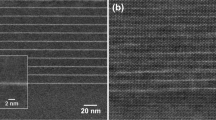Abstract
The strong piezoelectric field in the InxGa1−xN/GaN quantum well (QW) LEDs, separates the electrons and holes spatially, which decreases the luminescence. Various shapes and compositions of such QWs are studied to improve the performance. We have studied the transition energy (TE), overlap of electron and hole wave functions, band structures and field distributions of the parabolic QWs (PQW) through the self consistent solutions of Schrödinger and Poisson equations. The shape of the PQW is varied along with the compositions and dopings. The square of the overlap of electron and hole wave functions i.e. the transition probability (TP) is strikingly increased, compared to the rectangular QW and it is even higher than the symmetrically staggered QW. At a particular current density, for the same TE, the TP of the PQW increases more than two times that of the rectangular QWs. An important feature, desirable for the QW LEDs emerge. The change of the TE with increase in the current density is minimized. A brief theory, computational procedures and the results will be presented in details with suitable discussions.








Similar content being viewed by others
References
Arif, R.A., Zhao, H., Ee, Y.-K., Tansu, N.: Spontaneous emission and characteristics of staggered InGaN quantum-well light-emitting diodes. IEEE J. Quantum Electron. 44, 573–580 (2008)
Bastard, G., Mendez, E.E., Chang, L.L., Esaki, L.: Variational calculations on a quantum well in an electric field. Phys. Rev. B 28, 3241–3245 (1983)
Biswas, D., Panda, S.: Tunability of InGaN/GaN quantum well light emitting diodes through current. J. Appl. Phys. 114, 023105 (2013)
Biswas, D., Panda, S.: Conspicuous current dependence of the emission energy fromInxGa1−xN/GaN quantum well diodes. Optik 127, 1345–1348 (2016)
Biswas, D., Mistry, A., Gorai, A.: Constructive and comprehensive studies on the advantages of using staggered InxGa1−xN/InyGa1−yN QWs in LEDs. Opt. Mater. 66, 367–373 (2017)
Christmas, U.M., Andreev, A.D., Faux, D.A.: Calculation of electric field and optical transitions in In GaN/GaN quantum wells. J. Appl. Phys. 98, 073522 (2005)
Das, T., Kabi, S., Biswas, D.: Calculations for the band lineup of strained InxGa1−xN/GaN quantum wells: effects of strain on the band offsets. J. Appl. Phys. 105, 046101 (2009)
Dreyer, C.E., Janotti, A., Van de Walle, C.G., Vanderbilt, D.: Correct implementation of polarization constants in wurtzite Materials and Impact on III-nitrides. Phys. Rev. X 6, 021038 (2016)
Fiorentini, V., Bernardini, F., Ambacher, O.: Evidence for nonlinear macroscopic polarization in III–V nitride alloy heterostructures. Appl. Phys. Lett. 80, 1204–1206 (2002)
Gorai, A., Panda, S., Biswas, D.: Advantages of InGaN/InGaN quantum well light emitting diodes: better electron–hole overlap and stable output. Optik 140, 665–672 (2017)
Hangleiter, A., Im, J.S., Off, J., Scholz, F.: Optical properties of nitride quantum wells: how to separate fluctuations and polarization field effects. Phys. Status Solidi B 216, 427–430 (1999)
Lasher, G., Stern, F.: Spontaneous and stimulated recombination radiation insemiconductors. Phys. Rev. 133, A553–A563 (1964)
McBride, P.M., Yan, Q., Van de Walle, C.G.V.: Effects of In profile on simulations of InGaN/GaN multi-quantum-well light-emitting diodes. Appl. Phys. Lett. 105, 083507 (2014)
Mishra, P., Janjua, B., Ng, T.K., Shen, C., Salhi, A., Alyamani, A.Y., El-Desouki, M.M., Ooi, B.S.: Achieving uniform carrier distribution in MBE-grown compositionally graded InGaN multiple-quantum-well LEDs. IEEE Photonics J. 7, 1 (2015)
Morkoc, H.: Handbook of Nitride Semiconductors and Devices, vol. 1, 2, 3. Wiley-VCH, Weinheim (2009)
Panda, S., Biswas, D.: Effects of doping concentration on the transition energy of InGaN/GaN quantum well diodes. Solid State Commun. 168, 60–63 (2013)
Park, S.-H., Park, J., Yoon, E.: Optical gain in InGaN/GaN quantum well structures with embedded AlGaN δ layer. Appl. Phys. Lett. 90, 023508 (2007)
Park, S.-H., Moon, Y.-T., Han, D.-S., Park, J.S., Oh, M.-S., Ahn, D.: Comparison of light emission in InGaN/GaN light-emitting diodes with graded, triangular, and parabolic quantum-well structures. J. Korean Phys. Soc. 60, 505–508 (2012)
Piprek, J.: Efficiency droop in nitride-based light-emitting diodes. Phys. Status Solidi A 207, 2217–2225 (2010)
Singh, J.: Physics of Semiconductors and Their Heterostructures. McGraw-Hill, New York (1993)
Tan, I.-H., Snider, G.L., Chang, L.D., Hu, E.L.: A self-consistent solution of Schrödinger–Poisson equations using a nonuniform mesh. J. Appl. Phys. 68, 4071–4076 (1990)
Tan, C.-K., Borovac, D., Sun, W., Tansu, N.: InGaN/dilute-As GaNAs interface quantum well for red emitters. Sci. Rep. 6, 1–6 (2016)
Wu, J.: When group-III nitrides go infrared: new properties and perspectives. J. Appl. Phys. 106, 011101 (2009)
Yan, T., He, J., Yang, W., Rajabi, K., Chen, W., Wu, J., Kang, X., Zhang, G., Hu, X.: Optical properties of a novel parabolic quantum well structure in InGaN/GaN light emitters. Phys. Status Solidi A 212, 925–929 (2015)
Zhang, M., Bhattacharya, P., Singh, J., Hinckley, J.: Direct measurement of augerrecombination in In0.1Ga0.9N/GaN quantum wells and its impact on the efficiency of In0.1Ga0.9N/GaN multiple quantum well light emitting diodes. Appl. Phys. Lett. 95, 201108-1–201108-3 (2009)
Zhao, H., Arif, R.A., Ee, Y.-K., Tansu, N.: Self-consistent analysis of strain-compensated InGaN–AlGaN quantum wells for lasers and light-emitting diodes. IEEE J. Quantum Electron. 45, 66–78 (2009)
Acknowledgements
We would like to thank Dr. Siddhartha Panda, of this laboratory (Microwave and Solid State Electronics Laboratory, Institute of Radio physics and Electronics) for valuable discussions and illuminating suggestions. A. Mistry would like to thank the University Grants Commission, India, for financial support under the RGNF scheme. A. Gorai would also like to thank the University of Calcutta, India, for financial support under the Payodhinath Mukherjee research fellowship. The funding was provided by University Grants Commission (Grant No. F1-17.1/2014-15/RGNF-2014-15-SC-WES-67948), University of Calcutta (Grant No. ET/T/67).
Author information
Authors and Affiliations
Corresponding author
Additional information
Publisher's Note
Springer Nature remains neutral with regard to jurisdictional claims in published maps and institutional affiliations.
Rights and permissions
About this article
Cite this article
Mistry, A., Gorai, A. & Biswas, D. The electron–hole overlap in the parabolic quantum well light emitting diode is much superior to the rectangular: even to that of a staggered quantum well. Opt Quant Electron 51, 42 (2019). https://doi.org/10.1007/s11082-019-1761-8
Received:
Accepted:
Published:
DOI: https://doi.org/10.1007/s11082-019-1761-8




